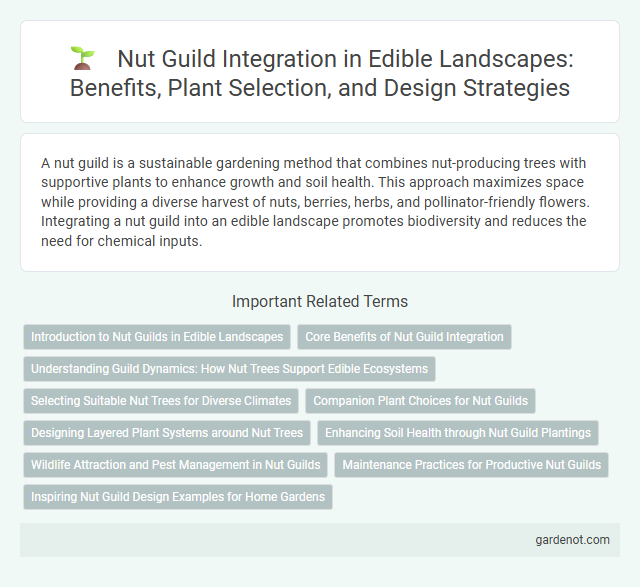A nut guild is a sustainable gardening method that combines nut-producing trees with supportive plants to enhance growth and soil health. This approach maximizes space while providing a diverse harvest of nuts, berries, herbs, and pollinator-friendly flowers. Integrating a nut guild into an edible landscape promotes biodiversity and reduces the need for chemical inputs.
Introduction to Nut Guilds in Edible Landscapes
Nut guilds in edible landscapes integrate nut-producing trees with compatible plants to enhance biodiversity, improve soil health, and increase overall yield. These guilds typically include nitrogen-fixing plants, dynamic accumulators, and ground covers that support tree growth and pest management. By mimicking natural ecosystems, nut guilds create sustainable, low-maintenance food production systems that maximize space and resources.
Core Benefits of Nut Guild Integration
Nut guild integration enhances edible landscapes by improving soil fertility through nitrogen-fixing plants, reducing pest incidence via diverse plant interactions, and increasing overall yield with complementary species that support nut trees. This agroforestry system promotes sustainable food production by creating resilient ecosystems and efficient nutrient cycling. Incorporating nut guilds maximizes space utilization and boosts long-term productivity in permaculture designs.
Understanding Guild Dynamics: How Nut Trees Support Edible Ecosystems
Nut guilds create synergistic ecosystems where nut trees function as foundational species, providing crucial shade, nutrient-rich leaf litter, and habitat for beneficial insects. These trees enhance soil fertility through nitrogen-fixing understory plants and support diverse pollinators, contributing to increased yields of both nuts and companion edible plants. Understanding nut guild dynamics reveals how integrating layered plant communities optimizes resource use, resilience, and productivity in edible landscapes.
Selecting Suitable Nut Trees for Diverse Climates
Selecting suitable nut trees for diverse climates in an edible landscape requires considering factors like chill hours, soil type, and drought tolerance. Species such as black walnut thrive in temperate zones with deep, well-drained soil, while chestnuts prefer acidic soils and can tolerate cooler climates. Incorporating varieties like pecans for warmer regions and hazelnuts for colder zones ensures a resilient and productive nut guild tailored to local environmental conditions.
Companion Plant Choices for Nut Guilds
Companion plant choices for nut guilds enhance soil fertility, attract beneficial insects, and provide ground cover to reduce weed growth. Ideal companions include nitrogen-fixing plants like clover and lupine, dynamic accumulators such as comfrey to mine nutrients, and pollinator-friendly flowers like echinacea and lavender to support ecosystem biodiversity. Integrating herbs like chives and marigolds deters pests naturally while improving the overall health of the nut tree environment.
Designing Layered Plant Systems around Nut Trees
Nut guilds enhance edible landscapes by designing layered plant systems around nut trees, maximizing space and biodiversity. These guilds integrate nitrogen-fixing plants, dynamic accumulators, and ground covers that improve soil health and support tree growth. By mimicking natural ecosystems, nut guilds create resilient, productive habitats that yield nuts, fruits, and beneficial herbs.
Enhancing Soil Health through Nut Guild Plantings
Nut guild plantings significantly enhance soil health by integrating nitrogen-fixing plants, deep-rooted species, and organic mulch layers that improve nutrient cycling and soil structure. The diversity within nut guilds promotes microbial activity and increases soil organic matter, fostering a resilient ecosystem capable of supporting robust nut tree growth. This symbiotic plant community reduces erosion, retains moisture, and sustains long-term fertility, making nut guilds an efficient strategy for sustainable edible landscapes.
Wildlife Attraction and Pest Management in Nut Guilds
Nut guilds enhance wildlife attraction by providing diverse food sources like nuts, berries, and insect-attracting plants, supporting birds, mammals, and beneficial insects. These guilds improve pest management through companion planting, where pest-repellent species reduce harmful insect populations naturally. Integrating nut trees with dynamic understory plants fosters a balanced ecosystem, minimizing the need for chemical interventions.
Maintenance Practices for Productive Nut Guilds
Maintaining a productive nut guild requires consistent practices such as regular mulching to retain soil moisture and suppress weeds, pruning to enhance air circulation and sunlight penetration, and monitoring for pests and diseases to prevent infestations. Incorporating nitrogen-fixing plants within the guild enriches soil fertility, reducing the need for synthetic fertilizers. Seasonal inspections and timely interventions promote healthy tree growth and maximize nut production.
Inspiring Nut Guild Design Examples for Home Gardens
Nut guilds combine nut trees like hazelnuts, walnuts, or chestnuts with complementary plants such as nitrogen-fixing shrubs, dynamic accumulators like comfrey, and ground covers to enhance soil fertility and biodiversity. Inspiring nut guild designs for home gardens include integrating dwarf nut trees with pollinator-attracting flowers, medicinal herbs, and edible berry bushes to create a self-sustaining ecosystem. These multilayered guilds optimize space, improve yields, and support beneficial insects, making them practical and productive additions to edible landscapes.
Nut guild Infographic

 gardenot.com
gardenot.com